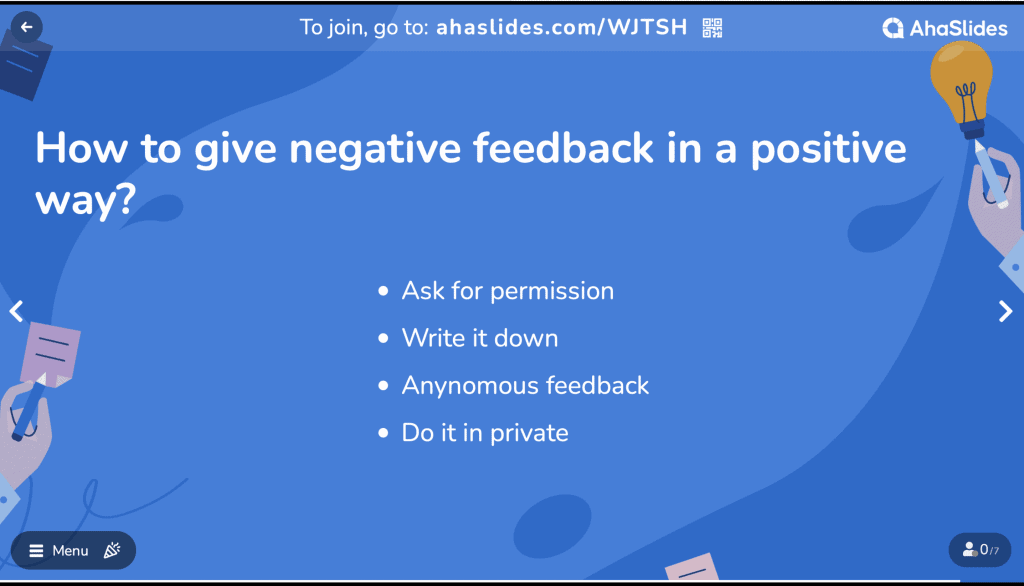Giving feedback is an art of communication and persuasion, challenging yet meaningful.
Like appraisal, feedback can be a positive or negative comment, and it is never easy to give feedback, whether it is feedback to your peers, friends, subordinates, colleagues, or bosses.
So how to give feedback effectively? Check out the top 12 tips and examples to ensure every feedback you give makes a certain impact.
Online poll makers boost survey engagement, while AhaSlides can teach you questionnaire design and anonymous survey best practices!
Table of Contents
- What is the importance of giving feedback?
- How to give feedback — In the Workplace
- How to give feedback — In the Schools
- Key Takeaways

Get to know your mates better! Set up an online survey now!
Use quiz and games on AhaSlides to create fun and interactive survey, to gather public opinions at work, in class or during small gathering
🚀 Create Free Survey☁️
What is the Importance of Giving Feedback?
"The most valuable thing you can receive is honest feedback, even if it's brutally critical", said Elon Musk.
Feedback is something that should never be overlooked. The feedback is like a breakfast, it brings benefits for individuals to grow, followed by the organization's development.
It is the key to unlocking improvement and progress, acting as a bridge between our expectations and the actual results we achieve.
When we receive feedback, we are given a mirror that allows us to reflect on our actions, intentions, and the impact we have on others.
By embracing feedback and using it to our advantage, we can achieve great things and continue to grow and develop as individuals and as a team.

How to give feedback — In the Workplace
When giving specifics, it is suggested to pay attention to our tone and be specific to ensure the receiver won't feel offended, overwhelmed, or ambiguous.
But these aren't enough for constructive feedback. Here are more selective tips and examples to help you to provide feedback in the workplace effectively, whether it is your boss, your managers, your colleagues, or your subordinates.
Tips #1: Focus on performance, not personality
How to give feedback to employees? “The review is about the work and how well it is being performed,” said Keary. So the first and foremost thing to remember when giving feedback in the workplace is to prioritize the performance and quality of the work being evaluated, rather than focusing on the individual's personality.
❌ "Your presentation skills are terrible."
✔️ "I noticed that the report you submitted last week was incomplete. Let's discuss how we can fix it."
Tips #2: Don’t wait for a quarterly review
Making feedback a daily routine activity sounds like a great idea. Time doesn't run slower to wait for us to improve. Take any chance to give feedback, for example, whenever you observe an employee performing well or going above and beyond, provide immediate positive feedback.
Tips #3: Do it in private
How to give feedback to colleagues? Be in their shoes when you give feedback. How will they feel when you scold or give unfavorable feedback to them in front of many people?
❌ Say it in front of other colleagues: "Mark, you're always late! Everyone notices it, and it's embarrassing.
✔️ Praise publicity:'' You've done a good job!" or, ask them to join a one-to-one discussion.

Tips #4: Be solution-oriented
How to give feedback to your boss? Feedback is not incidental. Especially when you want to give feedback to your superior. When providing feedback to your managers and boss, it's important to remember that your intention is to contribute positively to the team's success and the overall growth of the organization.
❌ "You never seem to understand our team's challenges."
✔️ I wanted to discuss something I've observed in our project meetings. [issues/problems] I've been thinking about a potential solution to address this.
Tips #5: Highlight the positives
How to give good feedback? Positive feedback can achieve the goal of helping your peers improve as effectively as negative criticism. After all, feedback loops shouldn't be a fright. It drives a motivation to become better and work harder.
❌ "You're always behind on deadlines."
✔️ "Your adaptability sets a positive example for the rest of the team."
Tips #6: Focus on one or two main points
When providing feedback, the effectiveness of your message can be greatly enhanced by keeping it focused and concise. The "less is more" principle applies here – sharpening in on one or two key points ensures that your feedback remains clear, actionable, and memorable.
💡For more inspiration of giving feedback, check out:
- Must-Know Facts about 360 Degree Feedback with +30 Examples in 2025
- 20+ Best Examples Of Feedback For Colleagues
- Best 19 Manager Feedback Examples In 2025
How to give feedback — In the Schools
How to give feedback to someone you know in an academic context, such as students, teachers, professors, or classmates? The following tips and examples will certainly ensure receivers' satisfaction and appreciation.
Tips #7: Anonymous feedback
Anonymous feedback is one of the best ways to give feedback in a classroom setting when teachers want to collect feedback from students. They can freely offer suggestions for improvement without worrying about negative consequences.
Tips #8: Ask for permission
Don't surprise them; instead, ask for permission to give feedback in advance. Whether they are teachers or students, or classmates, all are worth being respectful of and have a right to receive feedback about them. The reason is they can choose when and where they are most comfortable receiving feedback.
❌ "You're always so disorganized in class. It's frustrating."
✔️"I've noticed something and would appreciate your thoughts. Would it be alright if we discussed it?"
Tips #9: Make it part of the lesson
How to give feedback to students? For teachers and educators, there is no better way to give feedback to students than through teaching and learning. By making feedback an integral part of the lesson structure, students can learn from real-time guidance and self-assessment with active engagement.
✔️ In a Time management class, teachers can create a discussion time for students to share their ideas on punctuation, and suggest ways to be on time.

Tips #10: Write it down
Providing written feedback is as influential as talking directly to them in privacy. This best benefit is allowing the recipient to review and reflect on your comments. It can include positive observations, suggestions for growth, and actionable steps for improvement.
❌ "Your presentation was good, but it could be better."
✔️ "I appreciate your attention to detail in the project. But I suggest that you consider incorporating more supporting data to strengthen your analysis."
Tips #11: Compliment their efforts, not their talents
How to give feedback without overselling them? In schools, or workplaces, there is someone who might surpass others because of their talents, but it shouldn't be an excuse when giving poor feedback. Constructive feedback is about recognizing their effort, and what they have done to overcome obstacles, not about overpraising their talents.
❌ "You're naturally talented in this area, so your performance is expected."
✔️ "Your commitment to practicing and learning has clearly paid off. I appreciate your hard work."
Tips #12: Ask for feedback as well
Feedback should be a two-way street. When you give feedback, maintaining open communication involves inviting feedback from the recipient and can create a collaborative and inclusive environment where both parties can learn and grow.
✔️ "I've shared some thoughts on your project. I'm curious to know your thoughts on my feedback and whether you think it aligns with your vision. Let's have a conversation about it."
Key takeaways
I guarantee that you've learned a lot from this article. And I am happy to share with you an excellent helper to assist you give supportive and constructive feedback in a more comfortable and engaging manner.
💡Open an account with AhaSlides now and conduct anonymous feedback and survey for free.
Ref: Harvard Business Review | Lattice | 15five | Mirror | 360 Learning








